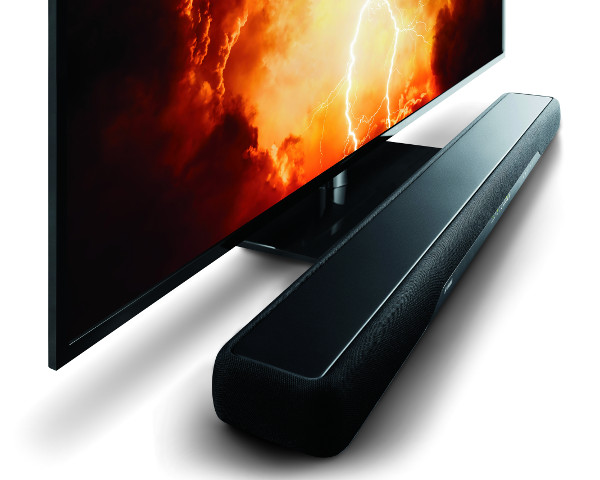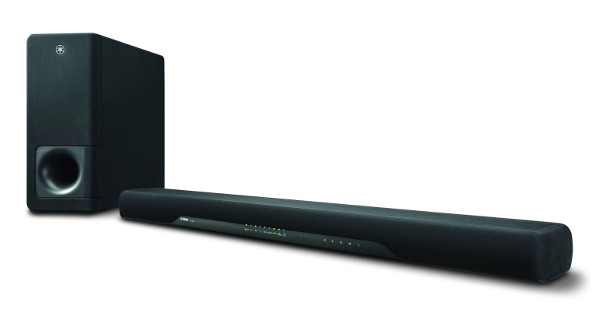Yamaha YAS-207 Soundbar System Review Page 2

Virtualized Tones and Movies
Although its tonal character varied according to mode, and even according to channel within a mode, the YAS-207 was in general a surprisingly good-sounding soundbar system for its $300 price. It may not have sounded good in every mode, but the right mode selection could make it sound good with any content I tried. The 3D Surround mode — which invokes DTS Virtual:X — had more of a treble emphasis than the regular Surround mode, especially in the front left/right and height left/right channels. The Clear Voice mode pushed up the center-channel level, and hardened the midrange a bit, but it definitely helped with dialog intelligibility when my window air conditioner was running. The Bass Extension mode, combined with my room’s standing wave, bloated the bass. I avoided using it and kept the sub volume control at, or slightly below, its midpoint. I don’t expect anything more than bare adequacy from a sub with a single 6.25-inch driver packaged with a $300 system.
Test signals from the Dolby Atmos Blu-ray Demo Disc (2015) confirmed what I’d learned in movie demos before and afterward. In Surround mode, the bar had a pleasingly warm tonal balance, generating a strong phantom center that was well timbre-matched to the sides. Surround channels lifted free from the bar but weren’t localized anywhere near the rear of the room.
In 3D Surround mode, the front left and right channels sizzled strongly, leaving the center and surrounds noticeably softer (but more palatable). The surround channels stepped 2 or 3 feet from the bar toward the listening position, with the left-surround channel stepping a few inches farther — probably due to my asymmetrical speaker placement, with its differing side-wall distances. The virtualizer managed to lift the height channels a few feet above the bar — nowhere near the ceiling, but definitely upward. Again, the effect was stronger in the left channel. And again, the front height channels had more sizzle compared with the rear height channels, at least with pink noise. But, no one listens to test signals for entertainment, and with program material, especially movies, the tonal shifts were less irritating.
The haunted-house movie Crimson Peak (utilizing only the 5.1 core of its DTS:X soundtrack) lost no time in triggering the virtualizer with an eerie vocal that drifted a couple of feet above the bar. A system with speakers placed around the room and decoding all layers of DTS:X (and Dolby Atmos) soundtracks would have created a 360-degree bubble to fill the room. With this soundbar-based Virtual:X, there was still a bubble, but it didn’t extend to either the ceiling or the listening position; it just hovered around the bar. However, switching the virtualizer in and out left no doubt that this smaller bubble could help lure me into the story. It heightened low-level surround effects, such as thunder and the creaking house. The little bubble was at its most impressive when a ballroom full of people erupted into applause.
Pixels (Dolby Atmos), surely one of the worst movies ever made, used early-1980s video-game nostalgia to fill the little bubble with gusts of harsh synthesized effects. Virtual:X’s function was easiest to hear when I cut back from 3D Surround to regular Surround, which would collapse the bubble. This was a tough tradeoff. The system offered more interesting effects with Virtual:X but was less fatiguing without it.
USS Indianapolis: Men of Courage (DTS-HD Master Audio) is a surround epic that starts with warplanes zooming toward the listener. The planes got only a few feet from the bar before dissolving in the center of the room; retaining greater realism is why we lay surround cables to physical rear speakers. Even so, the effect was modestly successful because it established a trajectory, and my imagination did the rest. Naval battle scenes were more comfortable in regular Surround than in edgy virtualized 3D Surround.

Virtualized Music
Richard Thompson’s Acoustic Classics II (FLAC 88.2/24) established what would become a familiar pattern in the two-channel demos: Stereo was consistently pleasant, if spatially narrow. The Surround mode provided variable results; sometimes, it was too “wet.” But at other times, as in the reverb-heavier “Pharaoh,” it mirrored the artist’s intention and got the job done. The 3D Surround mode was, unfortunately, unlistenably shrill more often than not with two-channel input. Thompson’s mature baritone and the bottom strings of his Lowden acoustic guitar fared best with the Subwoofer control at midpoint, a slightly higher setting than I’d used for movies.
The bar proved to be a surprisingly sensitive soulmate to Elliott Smith’s Figure 8 (CD), with its breathtaking serpentine chord sequences and complex but light-textured power-pop arrangements. The electric shimmer of “L.A.” and other tracks came through beautifully — rich, not thin — thanks to a warmish and musically adept midrange. The Surround mode helped some tracks by enlarging and Spector-izing the soundstage. This worked especially well with sparse arrangements that didn’t stray far from multitracked voice and acoustic guitar. With the sub dialed in, at midpoint and without Bass Extension, the rhythm section punched with appropriate weight.
A Violin for All Seasons (Chandos SACD converted to PCM) includes a full performance of Vivaldi’s Four Seasons plus a new work by Roxanna Panufnik, all performed by the BBC Symphony Orchestra, with Tasmin Little as both violin soloist and conductor. This multichannel disc turned up a useful distinction in the 3D Surround mode. With the SACD and CD stereo soundtracks, it remained hard to listen to. But with the SACD multichannel soundtrack, it provided a wider soundstage with less draconian tonal shift. Not surprisingly, Virtual:X seemed to prefer surround source material to stereo.
Traversing the bar’s listening modes, from Stereo to Surround to 3D Surround, was a matter of big-bigger-biggest. Solo violin passages sounded best in Stereo but were nearly as good in Surround &dmash; and by the way, there are very few soundbars that can competently handle a solo violin as well as this one does. Massed strings sounded best in either of the Surround modes, even allowing for the tonal shift when going from Surround to 3D Surround. Eventually, I concluded that the regular Surround mode was the best of both worlds for multichannel music.
The Yamaha YAS-207 is an intriguing and mostly successful attempt to bring the latest in virtual surround technology to an inexpensive soundbar. DTS Virtual:X works better with movies and other surround-encoded content, but for the rest, the other modes more than suffice. Simply as a speaker/amp combo, this bar-and-sub system is excellent for the price. Throw in a little new technology, and you’ve got a very attractive product.
Audio Editor Mark Fleischmann is the author of Practical Home Theater: A Guide to Video and Audio Systems, now available in both print and Kindle editions.



























































